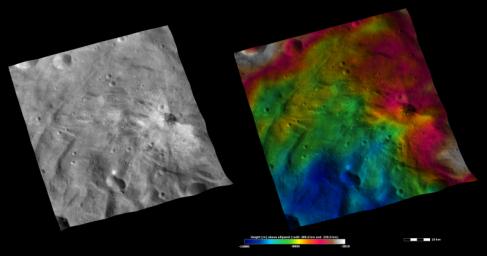Apparent Brightness and Topography Images of Justina Crater
Caption:
The left-hand image is a Dawn FC (framing camera) image, which shows the apparent brightness of Vesta's surface. The right-hand image is based on this apparent brightness image, which has had a color-coded height representation of the topography overlain onto it. The topography is calculated from a set of images that were observed from different viewing directions, which allows stereo reconstruction. The various colors correspond to the height of the area. The white and red areas in the topography image are the highest areas and the blue areas are the lowest areas. Justina crater is the middle-sized crater in the right of the images. Justina is surrounded by bright material, some of which forms rays, on all of its sides apart from the right side. In the topography image it can be seen that the area without bright material is the highest area around Justina crater. So perhaps there is no bright material in this area because as the material was thrown out of Justina crater it did not have sufficient energy to get high enough to cover this topographically high area.
These images are located in Vesta's Urbinia quadrangle, in Vesta's southern hemisphere. NASA's Dawn spacecraft obtained the apparent brightness image with its framing camera on Oct. 22, 2011. This image was taken through the camera's clear filter. The distance to the surface of Vesta is 700 kilometers (435 miles) and the image has a resolution of about 70 meters per pixel. This image was acquired during the HAMO (high-altitude mapping orbit) phase of the mission. These images are lambert-azimuthalmap projected.
Background Info:
The Dawn mission to Vesta and Ceres is managed by NASA's Jet Propulsion Laboratory, a division of the California Institute of Technology in Pasadena, for NASA's Science Mission Directorate, Washington D.C. UCLA is responsible for overall Dawn mission science. The Dawn framing cameras have been developed and built under the leadership of the Max Planck Institute for Solar System Research, Katlenburg-Lindau, Germany, with significant contributions by DLR German Aerospace Center, Institute of Planetary Research, Berlin, and in coordination with the Institute of Computer and Communication Network Engineering, Braunschweig. The framing camera project is funded by the Max Planck Society, DLR, and NASA/JPL.
More information about Dawn is online at
http://www.nasa.gov/dawn
and
http://dawn.jpl.nasa.gov
.
Cataloging Keywords:
| Name |
Value |
Additional Values |
| Target |
4 Vesta |
|
| System |
Main Belt |
|
| Target Type |
Asteroid |
|
| Mission |
Dawn |
|
| Instrument Host |
Dawn |
|
| Host Type |
Orbiter |
|
| Instrument |
Framing Camera (FC) |
|
| Detector |
|
|
| Extra Keywords |
Color, Crater, Map |
| Acquisition Date |
|
| Release Date |
2012-06-25 |
| Date in Caption |
2011-10-22 |
|
| Image Credit |
NASA/JPL-Caltech/UCLA/MPS/DLR/IDA |
| Source |
photojournal.jpl.nasa.gov/catalog/PIA15829 |
| Identifier |
PIA15829 |

 Planetary Data System
Planetary Data System
